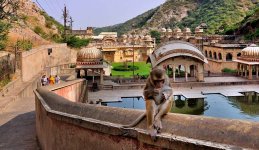Nestled within the rugged Aravalli Hills, the Galtaji Temple in Jaipur is a unique and sacred site. Also known as the "Monkey Temple," this ancient Hindu pilgrimage site is renowned not only for its beautiful architecture but also for its serene surroundings, natural springs, and abundant rhesus monkeys. Located about 10 kilometers from Jaipur, Galtaji Temple attracts both pilgrims and travelers who are looking for a spiritual experience away from the bustling city.
The site’s spiritual significance is elevated by the belief that the natural springs flowing here have sacred, purifying qualities. This has made Galtaji an essential stop for devout Hindus who come to cleanse themselves in the holy waters, especially during Makar Sankranti, an important Hindu festival marking the winter solstice.
There are seven natural water tanks within the temple complex, with the Galta Kund being the holiest and most revered. This kund is believed to have never run dry, despite the arid climate of Rajasthan, a phenomenon that adds to its spiritual allure. Pilgrims and tourists often take a dip in the kunds, which are said to have healing powers. The temple’s strategic location on the hillside provides scenic views of Jaipur and the surrounding landscape, offering visitors a perfect vantage point to admire the beauty of the Aravalli Hills.
The monkeys add a lively charm to the temple, and it is common to see them playing around the temple complex or being fed by pilgrims. However, visitors are advised to exercise caution while interacting with the monkeys, as they can sometimes become mischievous.
Whether you are seeking spiritual solace, architectural inspiration, or a closer look at Rajasthan's rich heritage, Galtaji Temple provides a meaningful experience that lingers long after you leave. With its unique blend of history, culture, and nature, this temple stands as a testament to Jaipur’s rich legacy of spirituality and artistry.
4o
Historical and Cultural Significance
The Galtaji Temple complex dates back over 500 years and has deep cultural and religious roots. According to legend, Saint Galav, a revered Hindu sage, meditated here for centuries, blessing the land with divine energy. In recognition of his dedication, the temple was constructed in the 18th century by Diwan Rao Kriparam, an attendant in the court of Maharaja Sawai Jai Singh II, who founded Jaipur. The temple complex honors Hindu gods and goddesses and contains shrines dedicated to Lord Ram, Lord Krishna, and Lord Hanuman.The site’s spiritual significance is elevated by the belief that the natural springs flowing here have sacred, purifying qualities. This has made Galtaji an essential stop for devout Hindus who come to cleanse themselves in the holy waters, especially during Makar Sankranti, an important Hindu festival marking the winter solstice.
Unique Architecture and Surroundings
One of the most striking aspects of Galtaji Temple is its architectural style, which diverges from typical temple architecture. Built in a traditional Rajput style with pink sandstone, the temple features intricately carved pillars, painted frescoes, and pavilions. The complex is a blend of temples, kunds (holy water tanks), and pavilions that create a peaceful and aesthetically captivating environment.There are seven natural water tanks within the temple complex, with the Galta Kund being the holiest and most revered. This kund is believed to have never run dry, despite the arid climate of Rajasthan, a phenomenon that adds to its spiritual allure. Pilgrims and tourists often take a dip in the kunds, which are said to have healing powers. The temple’s strategic location on the hillside provides scenic views of Jaipur and the surrounding landscape, offering visitors a perfect vantage point to admire the beauty of the Aravalli Hills.
The Monkey Temple: Home to Friendly Rhesus Monkeys
Galtaji Temple is popularly referred to as the "Monkey Temple" because of the large population of monkeys inhabiting the area. These monkeys, particularly the rhesus macaques, are considered sacred by locals and have become an integral part of the temple’s identity. The monkeys are accustomed to human presence and are generally friendly, making them a favorite among visitors, especially photographers.The monkeys add a lively charm to the temple, and it is common to see them playing around the temple complex or being fed by pilgrims. However, visitors are advised to exercise caution while interacting with the monkeys, as they can sometimes become mischievous.
Visiting Galtaji Temple
Galtaji Temple offers an ideal combination of spirituality, architecture, and natural beauty. The best time to visit is early morning or late afternoon when the weather is cooler, and the atmosphere is tranquil. As a revered pilgrimage site, visitors are encouraged to dress modestly and show respect for the religious practices observed at the temple.Whether you are seeking spiritual solace, architectural inspiration, or a closer look at Rajasthan's rich heritage, Galtaji Temple provides a meaningful experience that lingers long after you leave. With its unique blend of history, culture, and nature, this temple stands as a testament to Jaipur’s rich legacy of spirituality and artistry.
4o


